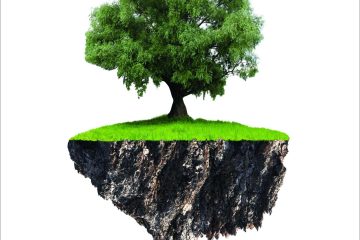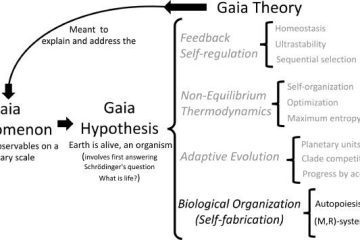Table of Contents
- Understanding the Gaia Hypothesis and Its Implications for Our Planet
- The Interconnectedness of Life Forms and the Earth’s Systems
- Examining the Scientific Evidence Supporting the Gaia Hypothesis
- Practical Applications of the Gaia Hypothesis in Environmental Policy
- Future Directions for Research and Global Sustainability Efforts
- Q&A
- The Way Forward
Understanding the Gaia Hypothesis and Its Implications for Our Planet
The Gaia Hypothesis proposes a profound connection between the Earth’s biological and physical components, suggesting that life on our planet interacts with its environment in a self-regulating manner. This means that living organisms actively contribute to the conditions that sustain life, maintaining a balance that promotes the health of the Earth as a whole. The implications of this perspective are far-reaching, as they challenge traditional views of nature as merely a backdrop for human activity. Instead, it positions humans as integral players in a larger system, emphasizing the need for a holistic understanding of ecological interactions.
One significant implication of the Gaia Hypothesis is the call for sustainability and environmental stewardship. By recognizing that our actions directly impact the delicate balance of ecosystems, individuals and communities are encouraged to adopt sustainable practices. This encompasses a wide range of activities, from reducing waste and conserving energy to supporting biodiversity and restoring ecosystems. Emphasizing our role in maintaining the Earth’s systems can lead to a shift in policies and personal behaviors, prioritizing the health of the planet over short-term gains.
Moreover, this hypothesis invites a re-examination of scientific and philosophical paradigms. The ideas behind Gaia encourage interdisciplinary collaboration, merging insights from biology, ecology, climate science, and even ethics. This comprehensive approach broadens our understanding of the interdependence of life and the environment, fostering innovations in conservation strategies and climate change mitigation. embracing the Gaia Hypothesis fosters a deeper appreciation of our planet’s complexity, urging collective responsibility for its future.

The Interconnectedness of Life Forms and the Earth’s Systems
The concept of life’s interdependence with Earth’s systems reveals a profound truth: all living organisms, from the smallest microbes to majestic trees, engage in a continuous dialogue with their environment. This interaction fosters an intricate web of relationships that maintain the balance necessary for life. Nutrient cycles, such as the nitrogen and carbon cycles, showcase this connectivity by demonstrating how living organisms utilize and transform essential elements, ultimately contributing to the sustainability of ecosystems. Furthermore, biodiversity is not merely a collection of species; rather, it represents a pool of resilience against changes, ensuring that if one species falters, others can adapt and fill the ecological void.
The dynamic nature of these relationships also extends to the atmosphere, hydrosphere, and lithosphere. Plants, for instance, play a crucial role in regulating the climate by absorbing carbon dioxide, while soil microorganisms decompose organic matter and release nutrients back into the ground. This bi-directional flow illustrates that alterations in one component can ripple through interconnected systems. For example, deforestation not only diminishes biodiversity but also disrupts local climate patterns, leading to issues such as droughts or floods. Key components of these interactions include:
- Photosynthesis by plants generating oxygen
- Soil health maintained by microorganisms
- Animal behavior affecting pollination and seed dispersal
Furthermore, understanding these interconnections emphasizes the urgency of conservation efforts. Protecting habitats is vital not only for individual species but also for the integrity of broader ecological networks. The preservation of wetlands, forests, and coral reefs, for instance, acts as a buffer against climate change, enhancing the resilience of global systems. By fostering a symbiotic relationship with nature, humans can mitigate destructive practices and pave the way for a sustainable future. An illustrative comparison of impacted versus preserved ecosystems reveals the stark difference in their vitality and functionality:
| Aspect | Impacted Ecosystem | Preserved Ecosystem |
|---|---|---|
| Biodiversity | Reduced species variety | Diverse species interactions |
| Climate Regulation | Increased carbon footprint | Stable climate conditions |
| Nutrient Cycling | Disrupted cycles | Effective nutrient redistribution |

Examining the Scientific Evidence Supporting the Gaia Hypothesis
The Gaia Hypothesis, proposed by scientist James Lovelock in the 1970s, posits that Earth functions as a self-regulating system where biotic and abiotic components interact in a complex web of relationships. The scientific community has scrutinized this theory, aiming to identify empirical evidence supporting its core assertions. Several studies have underscored the interconnectedness of life and the environment, suggesting that biological processes significantly influence the planet’s atmosphere, climate, and overall habitability. These findings often merge various scientific disciplines such as ecology, geology, and atmospheric science, reinforcing the idea of Earth as a cohesive, self-regulating entity.
A range of scientific observations lends credence to the Gaia Hypothesis. For example, the regulation of atmospheric gases, such as oxygen and carbon dioxide, is largely driven by living organisms. Plants, through photosynthesis, produce oxygen, maintaining levels that are conducive to life. Additionally, microorganisms play a crucial role in balancing atmospheric carbon, mitigating climate extremes. The interaction of these living systems reflects a dynamic equilibrium within the planet’s cycles, which further supports the idea that life and the Earth’s physical processes are inextricably linked. Key phenomena include:
- Oceanic Carbon Cycle: Phytoplankton absorb carbon dioxide, helping regulate ocean chemistry.
- Soil Microbial Activity: Fungi and bacteria decompose organic material, enriching soils while also influencing greenhouse gas emissions.
- Vegetation Feedback Loops: Changes in plant cover affect local rainfall patterns and temperature fluctuations.
Research into the Earth’s extremophiles—organisms that thrive in extreme environments—further illustrates the hypothesis. These organisms display remarkable adaptations that help stabilize environmental conditions during ecological fluctuations. For instance, studies on microbial life in extreme heat or salinity have shown how these tiny beings can influence larger biogeochemical cycles. More importantly, the role of biodiversity is increasingly recognized as essential for sustaining these regulatory functions. The table below highlights various extremophiles and their ecological contributions:
| Class of Extremophile | Habitat | Role in Ecosystem |
|---|---|---|
| Thermophiles | Hot Springs | Regulate nutrient cycling and enhance soil fertility. |
| Halophiles | Salt Flats | Maintain salt balance in saline ecosystems. |
| Piezophiles | Deep Ocean | Decompose organic material at extreme pressures, influencing carbon cycles. |
while the Gaia Hypothesis remains a subject of ongoing debate, the accumulation of evidence supporting the interconnectedness of life processes and Earth’s systems is compelling. The complexities of ecological networks and the adaptive capabilities of living organisms suggest that Earth’s ecosystems function in concert, promoting stability and resilience. Additionally, ongoing research continues to illuminate the critical relationship between living organisms and geological changes, fostering a deeper understanding of how life shapes and is shaped by the planet on which it thrives.

Practical Applications of the Gaia Hypothesis in Environmental Policy
The Gaia Hypothesis proposes that Earth functions as a self-regulating system, where living organisms interact with their inorganic surroundings to create a fit environment for life. This profound concept has significant implications for environmental policy. By viewing our planet through the lens of the Gaia Hypothesis, policymakers can adopt a holistic approach that considers the interconnectedness of ecosystems. Such a perspective encourages sustainable practices that promote not just conservation but also the enhancement of biodiversity.
Environmental policies inspired by the Gaia Hypothesis might focus on the following principles:
- Integration of Ecosystems: Encourage collaboration between different sectors and disciplines to enhance overall ecosystem health.
- Restoration Projects: Prioritize the restoration of degraded environments as essential to maintain the Earth’s regulatory functions.
- Climate Resilience: Develop strategies that enable natural systems to adapt to changing climates while preserving their essential functions.
To illustrate these concepts in action, consider the creation of a community-based environmental management framework. This framework can guide local efforts towards sustainable land use. Here’s a simple table showcasing potential initiatives:
| Initiative | Description | Expected Outcome |
|---|---|---|
| Urban Green Spaces | Establish parks and gardens in urban areas. | Improved air quality and biodiversity. |
| Community Agriculture | Support local farming practices. | Increased food security and reduced carbon footprint. |
| Water Conservation Programs | Implement rainwater harvesting and efficient irrigation. | Enhanced water quality and availability. |
the implications of the Gaia Hypothesis extend beyond theory, urging us towards actionable environmental policies. By embracing its principles, policymakers can foster an ethos of stewardship that prioritizes the health of our planet, acknowledging that humanity’s survival is intricately tied to the delicate balance of natural systems.

Future Directions for Research and Global Sustainability Efforts
As we move forward in our understanding of the Gaia Hypothesis and its implications for global sustainability, several key areas for future research emerge. Investigating the interconnections between natural systems and human activity can enhance our knowledge of how disruptions in one aspect can lead to cascading effects across the globe. Notably, researchers should focus on the following areas:
- Climate Change Mitigation: Exploring innovative approaches to reduce greenhouse gas emissions and adapt to climate consequences.
- Biodiversity Conservation: Understanding the role of diverse ecosystems in promoting resilience in changing climates.
- Renewable Energy Development: Advancing technologies that harness natural processes to generate sustainable energy sources.
Moreover, addressing socio-economic factors that impact global sustainability is paramount. Research must prioritize equitable resource distribution and identify how various communities can engage in sustainable practices based on their unique cultural contexts. Investigating the following dimensions may prove vital:
- Community Engagement: Studying how local populations can lead grassroots sustainability initiatives.
- Education and Awareness: Evaluating the effectiveness of programs designed to raise awareness about ecological interdependencies.
- Policy Integration: Analyzing how sustainability policies can be better integrated across sectors for holistic impact.
multidisciplinary collaborations will be critical to nurturing effective global sustainability efforts. The convergence of fields such as ecology, economics, and social sciences can yield innovative solutions to pressing problems. The following strategies could enhance collaborative research:
| Strategy | Description |
|---|---|
| Shared Data Platforms | Facilitating access to relevant research for diverse stakeholders |
| Interdisciplinary Conferences | Encouraging dialogue among experts to foster innovative ideas |
| Joint Grants and Funding | Pooling resources for research that spans multiple disciplines |
Q&A
Q&A on the Gaia Hypothesis Conclusion
Q: What is the Gaia Hypothesis? A: The Gaia Hypothesis is a scientific concept proposed by James Lovelock in the 1970s, suggesting that the Earth functions as a self-regulating, complex system comprised of living organisms and their inorganic surroundings. According to this hypothesis, Earth’s biological and physical components interact harmoniously to maintain conditions conducive to life.Q: What are the key components of the Gaia Hypothesis? A: The key components of the Gaia Hypothesis include the interconnectedness of life and the environment, the feedback systems that regulate the Earth’s climate and chemistry, and the idea that living organisms contribute to their own environment. This system of feedback loops, whether through CO2 absorption by plants or oceanic temperature regulation, showcases a balance that supports life.
Q: How does the Gaia Hypothesis relate to environmental science? A: The Gaia Hypothesis has greatly influenced environmental science by highlighting the importance of ecosystems and biodiversity in maintaining planetary health. It promotes the idea that human actions can disrupt this balance, leading to consequences like climate change, deforestation, and biodiversity loss. Understanding this interconnectedness encourages a more holistic approach to environmental conservation and sustainability.
Q: What criticisms have been directed at the Gaia Hypothesis? A: Critics argue that the Gaia Hypothesis lacks scientific rigor, as it sometimes borders on suggesting that the Earth has a purposeful intent in self-regulation. Detractors also express concerns about anthropomorphism—attributing human-like qualities to a planetary system. Additionally, some scientists contend that while ecosystems exhibit resilience, they are not immune to significant disruptions caused by human activities.
Q: What is the conclusion or current standing of the Gaia Hypothesis in scientific discourse? A: The conclusion surrounding the Gaia Hypothesis is complex and ongoing. While it is not universally accepted as a scientific theory, its core principles have been embraced within ecology and Earth sciences as frameworks for understanding environmental interactions. Researchers continue to explore the nuances of Earth’s systems, examining how life influences and adapts to changing conditions. Ultimately, the conversation around the Gaia Hypothesis serves as a reminder of the delicate balance of our planet and the critical nature of preserving it.
Q: How can individuals contribute to the principles outlined in the Gaia Hypothesis? A: Individuals can contribute by adopting sustainable practices, such as reducing waste, conserving energy, and supporting biodiversity. Engaging in community efforts focused on ecological preservation, participating in conservation initiatives, and advocating for policies that protect the environment are all ways to align personal actions with the principles of the Gaia Hypothesis. Awareness and education are also key in fostering a culture of sustainability.—This Q&A aims to clarify the concept of the Gaia Hypothesis, its implications, and its relevance in today’s environmental dialogue, providing a balanced view on its significance and critiques.



0 Comments